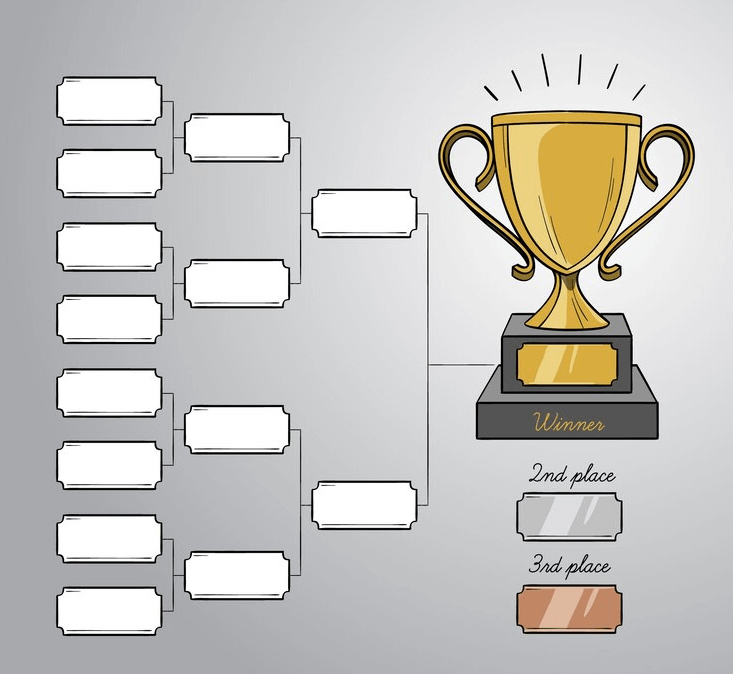The big college basketball tournament is upon us, and that means it’s time to fill out your college basketball bracket! Whether you’re a seasoned bracketologist or new to the game, navigating the sea of teams and matchups can be daunting. But fear not, we’ve got you covered with this step-by-step guide to filling out a winning bracket.
How to Fill Out a College Basketball Bracket

1. Understand the Basics
Before you start, it’s essential to understand the basics of how a college basketball bracket works. The bracket is a visual representation of the tournament’s matchups, with teams advancing based on wins and losses. Your goal is to predict the winners of each game, leading to the eventual champion.
All games are played at neutral sites, and are in different regions. Keep in mind that some teams will need to travel long distances for their games. The tournament is broken down in to multiple rounds:
- The First Four: Four play-in games played at the beginning of the tournament. These games typically decide two of the 16 seeds, an 11 seed, and between a 11-13 seed. Winners of these games move on to the full tournament.
- Round of 64: 32 games played based on seeding. 1 seeds will play 16 seeds in their region, 2 seeds will play 15 seeds, all the way to 8 seeds facing 9 seeds. Winners of each game will move on to the next round.
- Round of 32: 16 games played based on winners of previous round. 1/16 seeds will face 8/9 seeds, 2/15 seeds will face 7/10 seeds, and so on.
- Round of 16: 8 games played between winners of previous round. Often you’ll find a mix of mostly higher seeds, with a few “Cinderella” lower seed schools.
- Round of 8: 4 games between the final eight teams. Each winner will be named the champion of their respective region.
- Final 4: Last 4 teams play in 2 games. The winners move on to the championship game.
2. Get a Bracket:

You can find brackets online or in newspapers and magazines dedicated to March Madness. You can also create your own using a blank template. Make sure your bracket includes all 68 teams in the tournament and is divided into regions (East, West, South, Midwest).
Popular bracket creators online would be ESPN, CBS Sports and NCAA.com.
3. Research Teams and Matchups:
To make informed picks, research the teams and matchups. Look at each team’s record, strength of schedule, key players, and recent performance. Pay attention to matchups that may favor one team over another.
What are some team strengths and weaknesses? Did a key player suffer an injury and won’t be able to play? Does one 1 seed have a much easier path to the championship than other 1 seeds? These are all things to consider and break down as you’re doing your research.
4. Consider Seeding:
Teams are seeded from 1 to 16 within each region, with the top-seeded team playing the lowest-seeded team in the first round. While upsets are common in March Madness, higher-seeded teams are generally more likely to advance.
That being said, it’s important to pay attention to teams that may be underseeded or overseeded. Not all 1 seeds are created equal, just like not all 3, 4, 6 and 12 seeds are too. Try to spot teams you think have a chance to make an impact in the tournament that might be undervalued.
5. Fill Out Your Bracket:
Start by predicting the winners of the first-round games. Then, move on to the later rounds, filling in the winners of each matchup based on your predictions. Take your time and consider each matchup carefully.
It’s important to remember that generally speaking, higher seeds win more games. But taking the time to individually analyze each matchup will give you an edge on your opponents. Are there 1 seeds that are poor at defending the 3 point shot, and have drawn a region that has lots of good 3 point shooting teams? These are things you want to consider when analyzing matchups and who you want to take far in to the bracket.
6. Predict Upsets Wisely:
Upsets are a big part of March Madness, but don’t go overboard with your picks. While it’s fun to pick a few upsets, remember that higher-seeded teams are more likely to advance. Only two 16 seeds have ever upset a 1 seed in the first round. And on average, only 4.65 upsets happen in the first round, while 3.13 occur in the second round.
Upsets will make you look like a genius to your friend if you call them, but generally speaking, the higher seeds win more often than they lose. Key seed matchups to look at in the first round are the 11 seed over 6 seed, and 12 seed over 5 seed, each occurring over 30% of the time in tournament history.
7. Final Four and Champion:
Once you’ve filled out the early rounds, predict the teams that will make it to the Final Four and ultimately win the championship. Consider factors like team experience, coaching, and momentum, as well as easiest path to the final four and championship.
Try to analyze each region of the bracket to understand which higher seeds have the easiest path to the end of the tournament. 1-3 seeds are more likely to win the tournament, but not all top seeds are made equal. Try to find which teams you like in each region that you think have the most realistic chance to get to the end.
8. Have Fun and Follow Along:

March Madness is as much about the excitement and drama as it is about filling out a bracket. Enjoy the games, root for your picks, and see how your bracket stacks up against others. Find teams and underdogs you can root for too if your bracket starts to fall apart.
9. Join a Bracket Pool:
Consider joining a bracket pool with friends, family, or colleagues. Competing against others can add to the fun and excitement of the tournament. Make it a social event with others to make it more memorable and an annual experience.
10. Follow Through:
Once the tournament begins, keep track of your picks and see how they fare. The tournament is known for its unpredictability, so don’t be discouraged if your bracket doesn’t turn out as planned.
Filling out a college basketball bracket is a fun and exciting way to get in on the action of the college basketball tournament. By following these steps and using your knowledge of the teams and matchups, you’ll be well on your way to filling out a winning bracket. And if you can’t get enough of sports right now, check out the best sports to get your kids started on.






